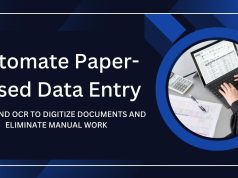Data entry automation replaces manual tasks with automated tools to save time, reduce errors, and boost productivity.
Data entry is one of those universal tasks that everyone dislikes. It’s repetitive, tedious, and prone to human error. For businesses, the time spent manually inputting information into web forms adds up quickly, pulling valuable team members away from more strategic, high-impact work. The good news is that you don’t have to be stuck in this cycle. It’s now easier than ever to automate data entry and streamline your workflows.
Automating data entry isn’t just about saving a few minutes here and there. It’s about transforming how your business operates. By implementing the right tools, you can ensure data accuracy, boost productivity, and free up your team to focus on what they do best: growing the business. This guide will walk you through why you should automate this process and explore the different methods available, from simple browser extensions to sophisticated robotic process automation (RPA).
Ready to say goodbye to manual data entry for good? Let’s explore how you can make it happen.
Why Should You Automate Data Entry?
Before we get into the “how,” it’s important to understand the “why.” Manually entering data into web forms is more than just a minor inconvenience; it can be a significant drain on your company’s resources. Here are the key benefits of making the switch to automation.

Increase Productivity and Efficiency
The most immediate benefit of automation is the time it saves. A task that might take an employee hours to complete can be done by an automated system in a fraction of the time. This boost in efficiency allows your team to redirect their efforts toward more creative and strategic tasks that require human intellect, such as customer engagement, market analysis, or product development. Instead of being data entry clerks, your employees can become data-driven decision-makers with automation.
Improve Data Accuracy
No matter how careful a person is, manual data entry is susceptible to human error. Typos, formatting mistakes, and duplicate entries are common issues that can lead to flawed data. Inaccurate data can have serious consequences, from skewed analytics to poor business decisions and damaged customer relationships. Automation tools follow a predefined set of rules, ensuring that data is entered consistently and accurately every single time. This reliability is crucial for maintaining data integrity across your business systems.
Reduce Operational Costs
Time is money, and the hours spent on manual data entry translate directly into labor costs. By automating these tasks, you can significantly reduce the number of employee hours dedicated to repetitive work. While there might be an initial investment in software or development, the long-term return on investment is substantial. The cost savings come not only from reduced labor but also from avoiding the expensive mistakes that can arise from inaccurate data.
Enhance Employee Morale
Let’s be honest: nobody enjoys mind-numbing, repetitive tasks. Forcing skilled employees to spend their days copying and pasting information can lead to boredom, frustration, and eventual burnout. By automating data entry, you empower your team to engage in more meaningful work that utilizes their unique skills and expertise. This shift can lead to higher job satisfaction, increased motivation, and better employee retention. Tools like cross-platform data entry automation make it easy for employees to work smarter, not harder.
How to Automate Data Entry into Web Forms
There are several methods to automate data entry, each suited for different needs, technical skill levels, and budgets. Here’s a breakdown of the most common approaches, from simple solutions to more advanced ones.

Browser Extensions and Form Fillers
For individuals or small teams with basic needs, browser extensions are a fantastic starting point. These tools are designed to automatically fill in web forms with predefined information.
Most modern browsers have built-in autofill features, and dedicated extensions can store multiple profiles to fill out complex forms. Check out how to automate browser data entry for practical tips.
- How they work: Most modern browsers have built-in autofill features that can save your name, address, and payment information. For more advanced needs, dedicated form-filler extensions can store multiple profiles and fill out more complex forms with a single click.
- Best for: Personal use, freelancers, and small business owners who frequently fill out the same types of forms online (e.g., shipping information, registration forms).
- Examples: LastPass (primarily a password manager, but has robust form-filling capabilities), RoboForm.
Web Scraping Tools with Form Submission Features
Many web scraping tools are known for extracting data from websites, but some also have the capability to input data. These tools can be programmed to navigate to a web form, enter data from a source file (like a CSV or Excel sheet), and submit the form.
- How they work: You configure the tool to identify the specific fields on a web form and map them to the columns in your data source. The tool then iterates through each row of your file, populating and submitting the form for each record.
- Best for: Businesses that need to transfer large amounts of data from one web source to another or from a file to a web application on a recurring basis.
- Examples: UiPath, Automation Anywhere, Octoparse.
Workflow Automation Platforms (No-Code/Low-Code)
Platforms like Zapier, Make (formerly Integromat), and Microsoft Power Automate allow you to create automated workflows that connect different apps and services without writing any code.
- How they work: These platforms use a trigger-and-action system. For example, you could set up a “Zap” where the trigger is a new row added to a Google Sheet. The action would be to take the data from that row and automatically enter it into a web form on another platform, like a CRM or a project management tool.
- Best for: Businesses of all sizes that want to automate processes across multiple cloud-based applications. It’s an excellent middle-ground solution that offers a high degree of flexibility without requiring technical expertise.

Custom Scripts (Python, JavaScript)
For complete control and customization, you can write your own scripts to automate data entry. Programming languages like Python (with libraries like Selenium or Playwright) or JavaScript are commonly used for this purpose. Developers can combine scripts with top data analysis techniques every business should know to streamline both data entry and data insights.
- How they work: A developer writes a script that automates a web browser to perform actions. The script can be programmed to open a website, locate form fields by their HTML attributes (like ID or class name), input data from a local file or database, and click the submit button.
- Best for: Complex or unique data entry tasks that off-the-shelf tools cannot handle. This approach requires a developer or someone with strong programming skills, but it offers unparalleled flexibility.
Robotic Process Automation (RPA)
RPA is a more advanced technology designed for enterprise-level automation. RPA “bots” are software robots that can mimic human actions to interact with digital systems and software. They can handle complex, multi-step processes that involve multiple applications.
RPA bots can handle multi-step, enterprise-level processes. Explore RPA- and OCR-driven automated workflows for end-to-end automation.
- How they work: RPA software is configured to perform a sequence of tasks just as a human would. This can include logging into applications, moving files, extracting data from documents, and, of course, entering data into web forms. The bots operate on the user interface level, which means they can work with almost any application, including legacy systems that don’t have APIs.
- Best for: Large organizations with high-volume, repetitive, and rule-based tasks that span multiple systems. RPA is a powerful solution for achieving end-to-end process automation.
- Examples: UiPath, Automation Anywhere, Blue Prism.
Choosing the Right Data Entry Automation Method
With so many automation methods available, choosing the right one can feel overwhelming. The key is to start with a clear understanding of your workflow, the volume of data you handle, and the complexity of the forms you’re dealing with. Businesses with straightforward, repetitive tasks may find that a simple browser extension meets their needs. But if your process involves multiple systems, conditional logic, or large datasets, more advanced tools like RPA or custom scripts may be necessary.
Choosing the right method also means considering how often the data entry process changes. If the web form structure updates frequently, maintaining custom scripts might require ongoing developer attention. If your organization needs flexibility and ease of use, a no-code automation tool can strike the perfect balance, enabling you to adjust workflows quickly without technical assistance. The best solution is one that aligns with your team’s skill level, your budget, and the long-term scalability of your operations.
Integrating Data Entry Automation with Existing Systems
Automation becomes truly effective when it fits seamlessly into your broader ecosystem of tools and processes. Whether it’s CRM systems like HubSpot or Xero, solutions like automated CRM data entry ensure data flows smoothly across departments, reducing bottlenecks and eliminating manual handoffs
One common integration strategy is connecting automation tools with cloud storage platforms such as Google Drive, Dropbox, or OneDrive. This setup allows your automation workflows to fetch data from shared spreadsheets or databases and update them in real-time. If your systems rely heavily on internal tools or legacy software, an RPA platform may be the best choice as it can interact with virtually any program—even those without APIs.
Ensuring Data Security and Compliance
Any process that handles customer or business data must prioritize security. When automating data entry, you’re often dealing with sensitive information such as personal details, billing info, or operational metrics. Therefore, security should never be an afterthought.
Before adopting an automation tool, investigate how it handles data encryption, access controls, and user permissions. Cloud-based platforms should comply with international standards like GDPR, HIPAA (if applicable), or SOC 2. For businesses with strict compliance needs, on-premise RPA solutions or self-hosted automation scripts can offer greater control. Additionally, regular audits and monitoring help ensure your automation workflows don’t accidentally expose or mismanage data. It’s important to treat your automated processes with the same level of oversight and governance as you would your human workforce.
Measuring the Impact of Data Entry Automation
Once automation is in place, the next step is evaluating its impact. Simply implementing an automation tool isn’t enough—you need to understand exactly how it’s improving your processes. Key indicators might include the reduction in time spent on tasks, the decrease in errors, or the improvement in your team’s capacity to handle higher-value work.
Many automation platforms offer built-in dashboards that track performance and highlight exceptions. If you’re using custom scripts, you can integrate logging features to track runtime, failures, and data quality metrics. Over time, these insights help you fine-tune your workflows, identify additional automation opportunities, and demonstrate the ROI to stakeholders. The goal is not just to automate a task but to create a system that continually evolves and adapts to your business needs.
The Future of Data Entry Automation

AI and machine learning continue to advance, enabling intelligent document processing and decision-making within workflows. Tools like AI data entry automation are moving businesses toward end-to-end automation, reducing manual effort and boosting efficiency.
Natural language models are also beginning to assist with decision-making within automation workflows, enabling bots to choose the right action based on context rather than rigid rules. This combination of AI and automation will allow businesses to automate even more complex, unpredictable processes. Ultimately, data entry automation is moving toward intelligent, end-to-end automation—reducing manual effort to near zero while delivering unprecedented efficiency and accuracy.
Free Your Business from Manual Work
Automating data entry is no longer a luxury reserved for large corporations with deep pockets. With a wide range of tools available, businesses of all sizes can find a solution that fits their needs and budget.
By embracing automation, you can unlock significant improvements in productivity, accuracy, and cost-efficiency. More importantly, you can free your team from the drudgery of repetitive tasks and empower them to focus on the strategic work that truly drives growth. Whether you start with a simple browser extension or implement a full-scale RPA solution, taking the first step to automate data entry is a crucial move toward building a more efficient and intelligent business.
Frequently Asked Questions (FAQ)
Is data entry automation difficult to set up?
Not necessarily. Many tools today are designed for non-technical users and offer intuitive interfaces that let you build workflows in minutes. More complex automation, such as custom scripts or RPA, may require technical expertise, but the long-term benefits often outweigh the initial setup time.
Will automation replace my employees?
Automation doesn’t eliminate jobs—it eliminates repetitive tasks. Instead of spending hours typing data, your team can shift their focus to strategic work such as analysis, customer service, innovation, and problem-solving. Automation enhances human productivity rather than replacing it.
What happens if a website changes its form layout?
If a web form changes, simple scripts or automation flows might break. However, most modern tools—especially RPA platforms—are designed to handle common UI changes. They allow you to update the workflow quickly without starting from scratch. As a best practice, always set up monitoring so you’re alerted when something goes wrong.
Is automated data entry secure?
Yes, as long as you choose tools that prioritize security. Look for encryption, access controls, audit logs, and compliance certifications. For highly sensitive data, consider self-hosted or on-premise automation solutions.
Can automation work with any website?
Most websites can be automated, but highly interactive sites or those with aggressive bot-detection measures may require more advanced tools like RPA or specialized scripts. In general, if a human can perform the task on the screen, an automation bot can too.










